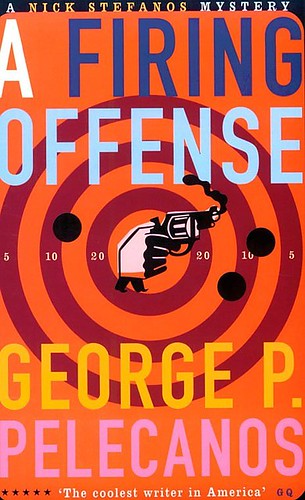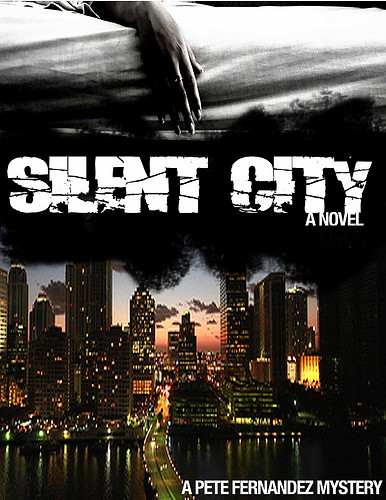One of the things I enjoyed writing most for the blog were my occasional "What I'm Reading/Viewing"-style posts, so I imagine I'll get back to those at some point in the new year. Additionally, one thing that sets me apart (because, let's face it, it's all about me, right?) from my fellow Leaguers is that I have no screenwriting aspirations. I mean, I'd write one if the stars aligned properly, but my interest lies mainly in prose. That's neither better or worse, just my preference.
I think it'd be helpful to chronicle, in a fashion similar in concept if not frequency to Cake Man's Writing Week columns, my experiences writing SILENT CITY. For those of you who don't recall, SILENT CITY is my long-gestating crime novel, set in modern day Miami. I've been working on it for over a year. After a few stops and starts and one massive outline rewrite, I finally feel like some forward progress is being made. I'm about 60 pages in and generally happy with where it's going.
So, in no particular order, here are a few things I've learned so far. I'll pop back in with more notes on the process as I continue to learn/unlearn/deal with them.
1. Always outline
One of the toughest lessons I learned was one of the first. My first pass at SILENT CITY was written in the first person, very much in the style of one of my favorite detective novels, George Pelecanos' A FIRING OFFENSE (author above). That wasn't really the main problem, though. I was working without an outline -- I mean, I had a general sense of where I wanted to go with the book and who the villains were. But, for all intents and purposes I was flying blind. Not a great idea when writing in a genre that is all about calculated surprises and tight plotting. By the time I realized (with some help from The League, of course) that I was wandering around the forest without a compass, I was about 40 pages in. Not a lot, if you're thinking in terms of novels, but it was a lot of writing for me. The longest work of fiction I'd ever produced was a 25-page short story, so the idea of having to rewrite my precious 40 pages was anathema to me. Cue long writing lull.
My mind kept coming back to SILENT CITY, though. So, after kicking myself a bit for delaying the inevitable, I sat down and hashed out a new outline, trying to save as much of my first draft as I could. While a noble endeavor, that in and of itself leads us to my second lesson.
2. Nothing is sacred
In my efforts to retroactively organize SILENT CITY, I crafted a competent, but fairly uninteresting -- and cluttered -- outline. Characters became redundant, scenes dragged on too long and the climax was, to be kind, nonexistent. Changes needed to be made if the project was to be salvaged. And saving the project would most probably involve starting over, from a blank page one. This thought was utterly frightening, especially considering I'd spent months "working" on the novel to varying degrees. Still, it was that or add SILENT CITY to the pile of unfinished projects I'd built up over the last few years. This was more unappealing than the former. It even drove me to write about it on the blog.
So, with a heavy heart, I saved my initial draft as "SILENTCITYold" and "SILENTCITYoutlineold" and started two new documents. One, a new outline with an ever-changing list of changes and tweaks at the top. The changes that had been enacted were bolded, other needed changes and suggestions (based on my own editing/notes and comments from my fellow Leaguers) were continually added to the top of the list. The second document, as expected, was an entirely new draft. One of the things I felt didn't really work with the original incarnation of the novel was that it was first person. Despite my love of the Pelecanos Nick Stefanos books, I wasn't George Pelecanos, and I felt more comfortable writing in third person. So, I pasted in what I found useful from the first draft and the new outline (which, in turn, took whatever was deemed worth saving from the original outline) into the blank document as I went along, purposely avoiding plopping too much into the blank document for fear it would overwhelm me and minimize my flexibility in terms of plotting and characterization, while still giving me some structure to comfortably work off.
This plan worked out pretty well. I was writing at a comfortable clip and the new changes were working. My new outline was received positively by the League and some others who got to read it. What could go wrong?
3. Find balance
In a few weeks, I'd gone from decrying the need for an outline (foolish) to becoming an apostle of my shiny, new outline (also foolish). After a good meeting where my outline was, for lack of a better word, approved by The League, I set off and started writing. 30 pages later, I had a few chapters that I was generally happy with. The only problem? They fell kind of flat. Motivations were murky, pacing was slightly off and -- lo, and behold -- some structural changes might be needed. But why? My outline was approved! Too bad, I learned. While a few weeks ago my outline read fine and made sense, it was just that -- an outline. The execution of said outline will either support the initial success of the outline or showcase a few problems. Why is your main character doing what he's doing? Who is the villain? What's with all the musical references? At the end of the day, you can have the best outline in the world, with every scene properly paced and each character fleshed out -- but it's still just an outline. An outline that, if your book is published, no one will ever read. With that realization, I learned that you have to try your best to adhere to the plans you've laid out, but also be flexible enough to allow these characters you've created -- and created to simulate real people as much as you can -- to live and breathe, and move around and do stuff. It happened with my protagonist a few days ago. Instead of wandering into the next scene I'd plotted for him, he decided to jump ahead to another point. Bad? No. I actually think it reads better. More work? In the short-term, yes. But it's worth it if it works. This also leads me to the final bit of advice for today.
4. It's a draft. You will rewrite.
It's natural, especially I think for a first-time novelist like me, to try and nail it on the first pass. You want to set the scene perfectly, nail the dialogue so everyone sounds unique and interesting, etc. Not gonna happen. If you want to get to the end -- and by end, I mean, the end of your first pass -- you'll need to let some things go. But this realization can only come after another, more important one: This is not the last time you will write this scene, or bit of dialogue, or description. I'm not familiar with any novels that were just written in one pass and sent for publication. I'm sure I'm wrong, but it's safe to say this is not the norm. With that in mind, you have to gauge things: How much time should you spend tinkering with something vs. whether or not you should press onward, knowing that tweaks (dialogue changes, expanding descriptions) that don't totally alter the structure and flow of the novel can be revisited at a later date. "Why put off now what you can do later?" you ask? Well, that's fair. But at what cost? The goal is to finish a draft. Once that's done, you begin the process of editing and rewriting, which is an aspect of writing unto itself. One I hope we can discuss here. Once I get there, of course.








